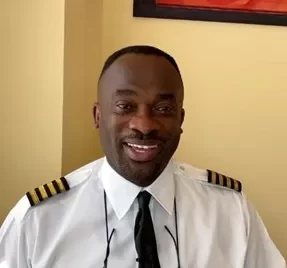Q. From our previous features, we understand the great impact of air laws to commercial aviation; were the laws also the breakthroughs the industry experienced?
A. Commercial aviation began to develop after the World War I in 1919. Many regulations were in place. What is so unique about the Chicago Convention was that all 52 countries, as of November 1944, came together to discuss uniform manner of operations in aviation. Prior to that, people were doing things in their own styles in their various parts of the world; but was safety really ensured?
Commercial aviation was greatly impacted by the aviation laws. We discussed the Chicago Convention, where 52 states came together to discuss the uniform manner of the aviation. Among the 52 states, as a chamber was discussing the uniform manner of aviation, coming up with various annexes to deal with different parts of aviation operation like maintenance, air traffic rules of the air, meteorological service, aviation medicine, search rescue, accident investigation, and others, another chamber was also dealing with the business interest of the whole aviation industry; and that had to do with the nine freedoms of the air, which basically addressed the rights a country grants to another to either overfly, land for technical reason, pick commercial traffic to/from another country as showcased in the previous features.
With all the preceding addressed, commercial aviation began to experience civilisation right from the time a passenger books/buys tickets for their flight all the way to disembarkation at their destination side. But there was still the clarion call to inventions and innovations as the skies got filled with planes each passing day, adverse weather also disrupting flights from time to time, and the demand for passenger travel exceeding supply as time went on.
Now, we will discuss the breakthroughs, because along the line, research had always been a process in the laboratories to test the various Physics of flights, engines, cabin designs and its operation in various meteorological conditions such as icing, thunderstorms, fogs – just to mention just a few.
Amazing! If not, what were some of the breakthroughs the industry experienced after the year 1919? We must first look at some few inventions and innovations that turned the industry around during 1930s and 1940s all the way to the late 1970s. Some are archaic today and some are still reigning, owing to the impact it made.
There are so many, but I will select a few to discuss how it impacted flying. First of all, the engines that were used for flight called propellers, though, were very good – using the technology we call intake, compression, combustion and exhaust, just as how the old vehicle engine used to work. Though good, along the way, it was found to be noisy; and in terms of speed, very slow. No engine had been invented to take care of a faster speed until the jet engine was invented in the late 1930s.
What are the advantages of the jet engine? The jet engine brought higher speed and added better features that could efficiently power and manage some aircraft systems, such as the air-conditioning, hydraulic power, electrical, anti-icing, and other essential gadgets. Basically, it was quieter, smooth and faster and needless to say, added flavour to the passenger experience. It may interest one to know that prior to the jet engine invention, there were times passengers had to insert cotton wool in their ears because of the noisy sound that emanated from the propellers. In terms of speed, for example, a thirty-minute flight operated by a jet from Accra to Kumasi would take almost an hour for the same distance by those propeller flights invented back in the day. And you can imagine travelling from Accra to London. Those flights could take up to ten (10) hours instead of six hours for a jet, and one can only imagine the stress that passengers of such journeys experienced. Trust me, air travelling was very stressful then as compared to this day, and one literally needed about two (2) days to unwind from the heavy tolls of long flights. Pilots and other support crew were also not spared from the afore-mentioned agonies, more especially if they had to fly through some thunderstorms and other adverse weather. Many thanks to those researchers who spent (and continue to spend) hours of sacrifice for advancing the industry!!
Another breakthrough was the RADAR, which is an acronym for Radio Detection and Ranging. The RADAR can be split into two phases. The first part is the air traffic control. Prior to Radar coming into air traffic system, what happened was that when air traffic wanted to separate so many aircraft in the sky, they had to rely on something called Pilot Position Report. For example, if pilot A transmits radio communication to the air traffic controller that “I am at this point, or estimating to be at this point at this time”, the air traffic controller had what we call an ‘imaginary map’ which draws the aircraft on track.
This map had the position of all aircraft in the airspace of the controller, and he had to use this plus other somewhat abstract mental exercises to be separating aircraft accordingly, using the Annex Two of the Chicago Convention. That was a very laborious task. On a very good day, it may be manageable to an experienced air traffic controller. However, what happens if thunderstorm were ahead of the route of the pilot? Basically, a pilot will ask for aircraft traffic permission to divert his course a couple of miles to avoid the thunderstorm in an effort to forestalling any possible catastrophe.
So, if pilot A says he is going off his track, and pilot B too is saying the same thing, and another pilot ahead saying the same thing, the imaginary map becomes a tedious venture because the air traffic controller has to keep plotting and replotting still in a bid to separate aircraft. One can only imagine what they suffered prior to the breakthrough.
The Radar was invented to replace such laborious tasks. There is a screen in front of him and as soon as the aircraft takes off, there is a contact with the pilot and the air traffic controller, making communication between them easy. All the air traffic controller needs to do is to input the flight number by the dot to know that this is aircraft A. The same process applies to another aircraft. All the dots of different aircraft are displayed on the screen of the air traffic controller. Thus, it makes it easy for the air traffic controller to separate the aircraft in the sky. That is also regulated by Annex Two of the convention, which is a breakthrough because now there is nothing like imagining anything on a map and resorting to tedious mental exercises.
The next is the Airborne Weather Radar. That is a feature introduced to the cockpit that enables the pilot to see ahead so many miles of 200 to 500 of his route, whether there are any thunderstorms his way. With that, he can avert when he needs to avoid the storm. Entering the storm has severe turbulence against the aircraft structure, passenger comfort, and possibly damaging other essential instruments and systems of the aircraft.
Artificial horizon, which is an instrument that can give pilots a coherent perception about the aircraft state at all times. For instance, is the plane climbing or descending? Is it banking to the left or right, or is it just flying straight and level. If it is climbing, then by how many degrees? All this could be determined since the invention of that instrument, and it has assisted to a larger extent in navigation in adverse weather conditions, such as clouds, fog, and in other weather conditions.
Also, a lot of breakthroughs happened on the passenger side. After the Annex Nine – which is facilitation – talking about what passengers had to go through, other things also started to make passenger flight easier; that is reservation, check-ins, and weighing of luggage systems. That made travel and commercial aviation very serious, and therefore, seen as a breakthrough.
Automated systems to process a passenger from the point he/she checks in at the airport, all the way to final destination. Also, the ticketing and ground baggage handling were also part of the breakthroughs in the aviation industry.
The Concord aircraft cannot be skipped in the breakthroughs. Concord was an aircraft with jet engine, which was not only faster and quieter, but also was travelling twice the speed of sound at 2000km/ph. That meant that business travellers who had meetings across Europe and America side, instead of doing a 7 to 9-hour journey by jet aircraft, could do half of it almost 2 to 3 hours on a return trip of the same day.
The Concord was for the elite business travellers who had urgent meetings to attend. Before the aircraft and jet aircraft came, ocean liners were most of the things that were used to cross the pond (Atlantic Ocean, for instance) from any part. Ocean liners took almost one month to cross a point, normal jet line was between 7 to 9 hours, and then came the Concord, which did less than half the time for the same task – 3 hours to cross the Atlantic Ocean from Europe). Today, a jet airline does 7 hours.
The other breakthroughs were the aircraft manufacturing companies – like Boeing and Airbus – to effect some feats; and a prominent one was the Boeing 747, popularly known as the Jumbo Jet, which launched in September 1968 and did its first flight on 9th February, 1969. It got certified in December of that same year, and PANAMERICAN (PANAM) was the launch customer on 22nd January, 1970. The Jumbo Jet was quieter, faster and able to carry at least 400 passengers in an upper and lower cabin. It has exclusive services and special treats.
The Airbus, which was a joint venture of French and German aerospace firms and later joined by British and Spanish firms, came on to the scene with their first brand(A300) in 1974; and as time went on, they launched so many brands like the A320/330/340/350 up until the year 2005, when they rolled out their A380 which was a best fit/match for their rival Jumbo Jet .The A380 also has many features as its rival B747 like the upper and lower deck cabin that can carry about 400 passengers and other cabin comforts . All these excellent feats continued and still continue to make the commercial aviation a God-sent venture.
From the pilot’s point of view, cockpit instrumentation improved tremendously from a virtual empty cockpit, without even a pilot seat. Orville and Wilbur Wright flew a seatless flyer ONE with only a compass and a speed indicator since 1903. Today, the fleet of airplanes with sophisticated instrumentation that can virtually fly themselves from take-off to landing speaks volumes of the breakthroughs that came in handy since commercial aviation was birthed.
Q. In a nutshell how will you describe the call to civilization, and aero breakthroughs?
A. The end of chaos and call to civilisation, invention and innovation have registered an indelible mark in the whole aviation industry from 17th December, 1903 to date.
All we can say is to thank the team that put regulations together as and when needed. Those who spent their time at conventions, coming up with annexes and freedoms. All the passengers who went through inconveniences before the laws were enacted – all such people are not to be taken for granted. They were the ‘Guinea-pigs’ to test aviation before all its laws were enacted. As far as civilisation was concerned, the laws ushered it into the industry to a great extent in terms of the uniform manner of aviation. That is not to say that the Chicago Convention brought the whole aviation laws to an end. Laws are still being enacted as and when necessary for improvement.
We doff our hats to all passengers who boarded the first flight before all the laws were enacted. We say ‘kudos’ to them for their sacrifices. We bless and glorify them for all they did to make the industry a better one.
Now, for the researchers in the laboratory in the industry who continue to come up with a lot of things to make flying easier, we say ‘kudos’!
The Flyer One machine in 1903 was just a device that had no seat for the pilot. Today, a lot of research has been carried out, ranging from giving the pilot accurate perception of the aircraft.
Now, we have navigational instruments that are sophisticated like using the Google map. That is not to say flying has become cheap, but things are easier with the auto pilot system that has helped to reduce workload and cockpit for the two crew to concentrate on other equally important tasks during flight.
We thank all the people in the laboratories still conducting research for innovation and invention. Now, we even have well established criteria on what kind of training pilots and other support team should undergo, how do we mark pilot competence, how they are selected for airline jobs, military jobs and aviation-related jobs.
Those days, flying was like going to war – owing to the accompanying inconveniences. People even took solace in travelling with their families in case of any casualty, in order to die with them.










